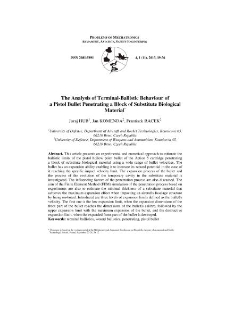Nasza Biblioteka Cyfrowa udostępnia 1 868 obiektów cyfrowych
Obiekt
Tytuł: The Analysis of Terminal-Ballistic Behaviour of a Pistol Bullet Penetrating a Block of Substitute Biological Material ; The Analysis of Terminal-Ballistic Behaviour of a Pistol Bullet Penetrating a Block of Substitute Biological Material
Współtwórca:
Jan KOMENDA, Frantisek RACEK ; Jan KOMENDA, Frantisek RACEK
Abstrakt:
This article presents an experimental and numerical approach to estimate the ballistic limits of the pistol hollow point bullet of the Action 5 cartridge penetrating a block of substitute biological material using a wide range of bullet velocities. The bullet has an expansion ability enabling it to increase its wound potential in the case of it reaching the specific impact velocity limit. The expansion process of the bullet and the process of the evolution of the temporary cavity in the substitute material is investigated. The influencing factors of the penetration process are also discussed. The aim of the Finite Element Method (FEM) simulation of the penetration process based on experiments are also to estimate the minimal thickness of a substitute material that achieves the maximum expansion effect when impacting an aircrafts fuselage structure by firing on-board. Introduced are three levels of expansion limits defined as the bullet‘s velocity. The first one is the low expansion limit, when the expansion dimensions of the front part of the bullet reaches the dimensions of the bullet’s calibre, followed by the upper expansion limit with the maximum expansion of the bullet, and the destructive expansion limit, when the expanded front part of the bullet is destroyed.
;
This article presents an experimental and numerical approach to estimate the ballistic limits of the pistol hollow point bullet of the Action 5 cartridge penetrating a block of substitute biological material using a wide range of bullet velocities. The bullet has an expansion ability enabling it to increase its wound potential in the case of it reaching the specific impact velocity limit. The expansion process of the bullet and the process of the evolution of the temporary cavity in the substitute material is investigated. The influencing factors of the penetration process are also discussed. The aim of the Finite Element Method (FEM) simulation of the penetration process based on experiments are also to estimate the minimal thickness of a substitute material that achieves the maximum expansion effect when impacting an aircrafts fuselage structure by firing on-board. Introduced are three levels of expansion limits defined as the bullet‘s velocity. The first one is the low expansion limit, when the expansion dimensions of the front part of the bullet reaches the dimensions of the bullet’s calibre, followed by the upper expansion limit with the maximum expansion of the bullet, and the destructive expansion limit, when the expanded front part of the bullet is destroyed.
Miejsce wydania:
Warszawa
;
Warszawa
Wydawca:
Wojskowa Akademia Techniczna ; Wojskowa Akademia Techniczna
Data utworzenia:
Data wydania:
Rozmiar:
Identyfikator:
oai:ribes-88.man.poznan.pl:2381
ISSN elektroniczny:
ISSN drukowany:
Język:
Właściciel praw:
Wojskowa Akademia Techniczna ; Wojskowa Akademia Techniczna
Strona początkowa:
Strona końcowa:
Tom:
Słowa kluczowe:
terminal ballistics, wound ballistics, penetrating, pistol bullet ; terminal ballistics, wound ballistics, penetrating, pistol bullet
Kolekcje, do których przypisany jest obiekt:
Data ostatniej modyfikacji:
25 sie 2025
Data dodania obiektu:
25 sie 2025
Liczba wyświetleń treści obiektu:
0
Wszystkie dostępne wersje tego obiektu:
https://ribes-88.man.poznan.pl/publication/2681
Wyświetl opis w formacie RDF:
Wyświetl opis w formacie OAI-PMH:
| Nazwa wydania | Data |
|---|---|
| The Analysis of Terminal-Ballistic Behaviour of a Pistol Bullet Penetrating a Block of Substitute Biological Material | 25 sie 2025 |
Obiekty Podobne
Adam WIŚNIEWSKI Dawid PACEK

